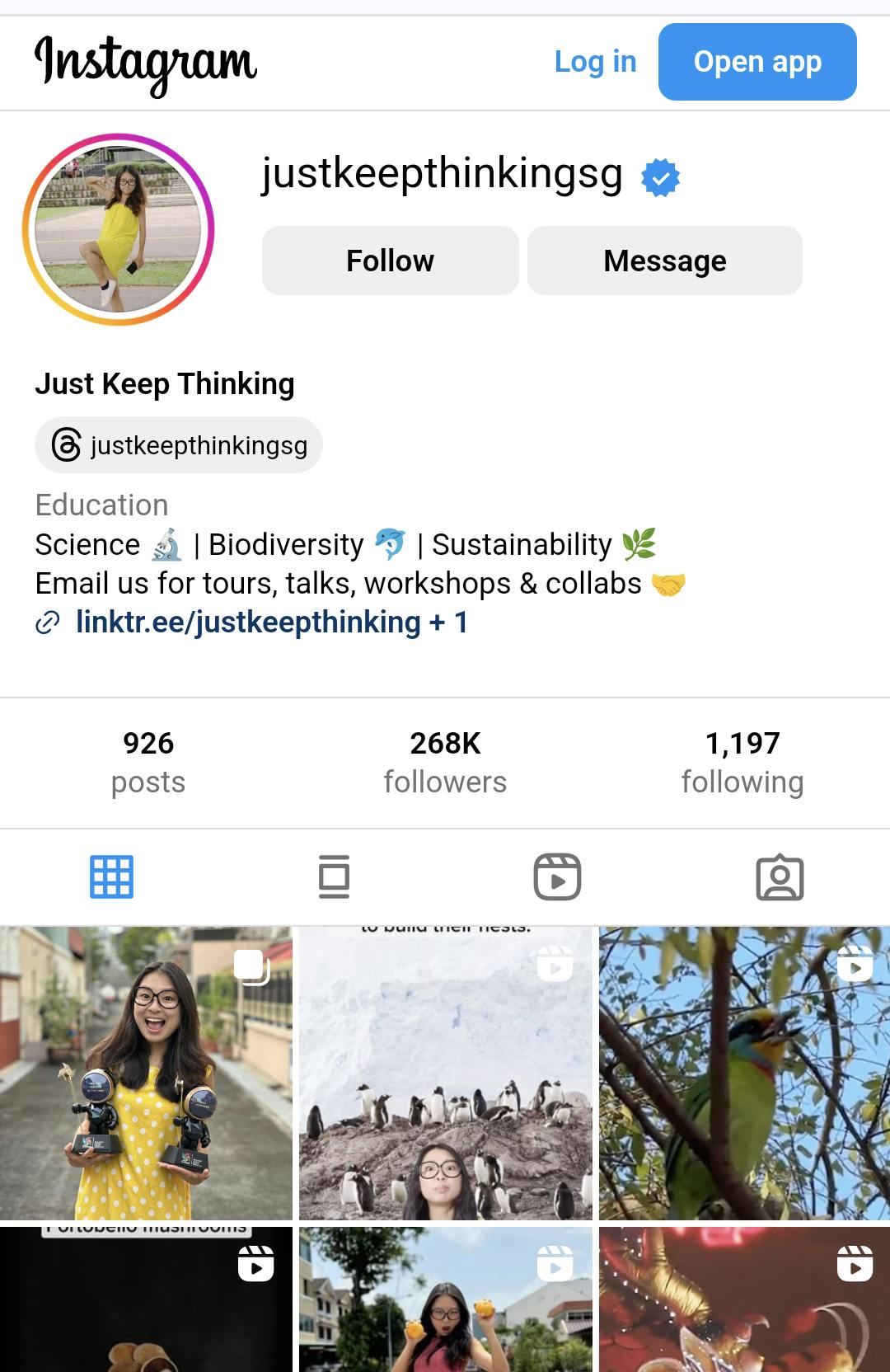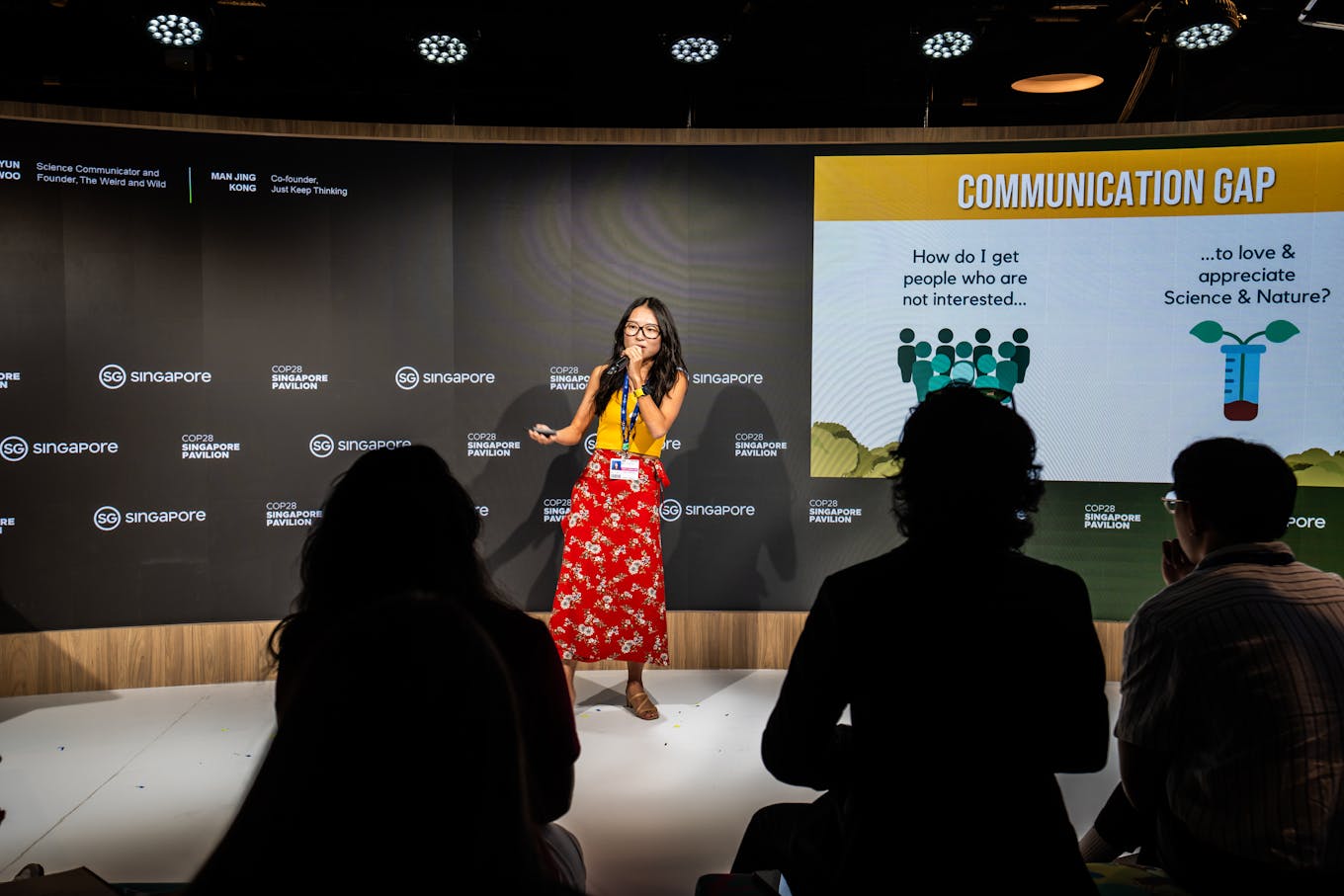Ever wondered what could be living inside cloves of spoilt garlic? Or under the sand of Singapore coasts? Maybe, maybe not. But Kong Man Jing wants you to care, and she seems to have a knack for piquing people’s interest with short-form nature and climate storytelling, judging by her hundreds of thousands of online followers.
To continue reading, subscribe to Eco‑Business.
There's something for everyone. We offer a range of subscription plans.
- Access our stories and receive our Insights Weekly newsletter with the free EB Member plan.
- Unlock unlimited access to our content and archive with EB Circle.
- Publish your content with EB Premium.
The 30-year-old has made herself somewhat a household name in Singapore among young nature enthusiasts and their parents. In 2019, she co-founded Just Keep Thinking, a science and biodiversity channel on social media, where she goes by the name Biogirl MJ.
Her minute-long videos feature biodiversity trivia – for instance why throwing sea stars back into the sea may not be a good idea – interspersed with facts you didn’t know you needed – such as how a pimple patch works. All videos start with her iconic and energetic “Hi guys!”, and features her in yellow outfits and black-framed spectacles. Just Keep Thinking has some 275,000 followers on Instagram and 130,000 on TikTok.
Recently, Kong has pivoted into climate and sustainability topics, such as clean energy and the carbon markets. She can no longer rely on the appeal of cute animals to hold her young viewers’ attention, and some have told her that the new content feels somewhat dry. Where she takes on branded work – including with the Singapore government – she tries to find the right balance between building trust and having the autonomy to do things her way.
There is also the issue of presenting a nuanced story amid a plethora of competing climate narratives. The complexities were made clear to Kong during her trip to the COP28 global climate summit in Dubai late last year.
“But I see it as a challenge for me, and that is why I am doing more on such topics. I keep thinking about how I can present complex issues better, how I can make them more fun and interesting,” Kong said. While she tracks monthly viewership numbers, it is individual anecdotes of youths launching their own sustainability initiatives after watching Just Keep Thinking that keeps her going, she added.
On the back of her Sustainability Leadership Youth A-List win, Eco-Business spoke with Kong about her future plans, how she maintains her unique style while working with sponsors, and her dream of a big break in the documentary space.
Tell us your origin story.

Just Keep Thinking has some 270,000 followers on Instagram, and another 130,000 on Tiktok.
It is not like I had green fingers since I was five. I only got interested in nature and wildlife when I went for a trip to Saint John’s Island (off mainland Singapore) back in junior college, when I explored the mangroves, intertidal zone and the forests there.
That was when I realised, Singapore has so much crazy wildlife, but no one knows about it. Then in university, I studied environmental biology and got to know more about the biodiversity and environmental issues we face.
Back then, we had a close-knit but very small biodiversity community in Singapore. It was always the same few people meeting each other. So I had been thinking about how to reach out to more people.
Later I met Raye, my partner, whom I co-founded Just Keep Thinking with. He was a videographer and didn’t know anything about the environment. But once we went snorkelling together, and he filmed me using his GoPro. While waiting for a sampan boat, I picked up a dead coral and just started talking about it, pointing out the coralites, where the polyps used to be. I was being my usual self.
Later, we realised that it could be a fun educational video, and started a channel to post these clips online. Some of our first videos ended up having about 14,000 views, when we still had zero followers. That’s when we realised we had something quite valuable, and the rest is history.
I sometimes have kids or their parents tell me about how excited they are when watching my videos together. It is very heartwarming, and I feel this increases their access to environmental education that they may not get in school.
What were your highlights of 2023?
Quite a lot happened. I went on a trip to Antarctica, which I had won from an environmental advocacy contest organised by [real estate firm] City Developments Limited.
Last year we also expanded our programmes, so I gave many talks in schools, which I really enjoy. We released a wildlife documentary series last year in partnership with [state broadcaster] Mediacorp, that was fun, and could be a first step towards bigger shows in the future.
Recently, I went to COP28 as an official partner for the Singapore pavilion. I was there as a science communicator, I never knew my skills could be useful in representing Singapore at a global stage. It is something I’m really proud of and grateful for.
How did you find the experience of attending COP28?
It might sound like an exaggeration but it was really life-changing for me. In Singapore, you tend to see things through a local lens,which can make you somewhat narrow-minded. Then when you step out and see the world, how countries prioritise their national interests in the climate conference … you realise the reality of the very pragmatic world we live in.
In Singapore, you have an issue, you complain about it and it gets solved – we are quite pampered that way. On the world stage, you make noise that way, you will just be left alone. So if you want to move the needle on climate action, you really require a lot of collaboration, talking, convincing people, making friends and networking.
I had access to closed-door negotiations while there, and I got to see our environment minister Grace Fu in action – she was a co-facilitator for the climate mitigation workstream. Leading up to the final decision text, she was meeting with officials from countries unhappy with how things stood. Someone said to her: “We cannot phase out fossil fuels at all, that is impossible”. Our minister asked about their challenges, and reiterated the need for a net-zero future. Interpersonal soft skills were so important in that context.
How has COP28 influenced the way you make your videos?
From the beginning, our videos have never been preachy – they’re meant for people to ponder about issues. Attending COP28 and interacting with people from other countries made me realise that the way we relate to environmental issues could be vastly different. This is something I keep in mind more often these days, because our channel does reach regional and Western audiences.
This means when I am researching certain issues, I would pay attention to historical nuances and the wording I should use. For instance, on phasing out coal, there are some communities out there who really need it as the cheapest option, and cannot wind down quickly after just building out their infrastructure. I need to present to my audience a fair telling of stories.
Are there certain topics you find harder to create content on?
We started out as a biodiversity-focused channel, but now we are talking more about climate change and sustainability issues. They aren’t the sexiest topics out there.
For biodiversity content, if you have a cute animal, it easily piques curiosity. Sustainability topics like carbon credits and renewable energy can get quite dry. Just showing a solar panel is so boring! I think this is a challenge many content creators are facing.
It is rare, but we do get comments such as, “I want to see more biodiversity stuff”, or that a video “is too dry for my liking”. That’s totally fine. We try our best, and I think we still managed to make most of the sustainability content as interesting as possible.
The challenge keeps me going too. For instance I’ve tried to explain carbon markets using supermarkets where people buy and sell tonnes of carbon, to make it as palatable to laymen as possible.
The goal of my channel is really to make more people interested in environmental issues. Some people may end up becoming environmentalists, which is great, but I think it is good enough for me if people just become more curious about sustainability. Then if they want to learn more, there are other platforms that cover issues in-depth. But without this curiosity they will never engage with these topics by themselves.

Kong Man Jing was a partner at Singapore’s COP28 country pavilion. Image: Kong Man Jing.
What would you say are the pros and cons of minute-long social media reels when it comes to science communication?
You have the potential to reach millions of people around the world, I think that is the biggest advantage compared to any other platforms out there. For television – I think kids still watch documentaries, but otherwise I think few watch television nowadays.
People’s attention spans are also shorter now, so they enjoy shorter reels – our longest videos won’t go past 90 seconds or so. The emergence of Tiktok really changed the whole social media scene, and we have to change with the times.
Still, things come and go – I do see longer form content coming back. That’s how social media is, you never know what happens next.
But with social media content now, I do have to give up a lot on the details and jargon. Personally, with a science background, I’m used to introduction – methodology – results – discussion and so on. I can’t do that now, and if I go too in-depth, I lose my target audience.
I think this is still a reasonable trade-off. The idea is still to pique people’s interest first. I keep that goal in mind and create videos based on that. If people want to learn more, there are a lot of avenues for them to do so, and I don’t have to be replicating that. I’m sure there are many people out there doing in-depth content. They may not get the same viewership [as me], but I think they have a more dedicated audience. My goal is to increase the number of people that go to them.
How do you measure the impact you create with your content?
I suppose the best way on social media is via the metrics – we have data to show who watches our content. On Instagram we have 30 million viewers monthly, and we have 500,000 followers across all platforms. I’m quite proud of what we’ve achieved with fun and educational content. It shows that social media can be more than lifestyle skits.
Whether these numbers will actually turn into real and meaningful action? This is something I cannot really confirm. But I do hear stories of people being inspired by our videos. There is this one kid, one of our earliest followers, who started an Eco Club in her primary school after watching our videos. This really touched my heart. I realised I have to take more responsibility for my content, rather than just posting any content I want – I have to take this a little more seriously now!
Some of my other viewers eventually joined the ecology scene in Singapore too. I have a friend who got very interested in snakes after watching one of our videos, and he is now one of the best snake enthusiasts I know in Singapore. He’s a snake expert right now. We’ve also had people messaging us saying they are considering studying environmental science because of what they have learnt from our videos. These are the stories that keep me going.
More content creators are taking to social media to share about sustainability. Is there room for everyone to talk about these issues?
It’s definitely a good thing. I’m happy to see more people encouraging others to care about the environment.
There is a flip side to it, though. There are some who aren’t very genuine with their messaging, or clearly do not know enough on the topics they are sharing about. Maybe they are paid to do it, or they just want to jump on a trend. It is totally fine to see this as a business opportunity, but it also comes with a responsibility to know what you are talking about. It reflects badly too, especially when their videos attract negative comments from the public.
I remember seeing an influencer on Tiktok writing about how to lead a more sustainable lifestyle by adopting certain greener products or practices. And the first few comments on the video were people saying, “don’t lie, I’m sure you don’t do that all the time”. It looks really bad on the influencer, but you can also see how it is weird when, out of nowhere, someone claims to want to be sustainable on a video.
Even in my own videos, I don’t claim to know everything about sustainability, I’m still learning along the way, and I will only speak about what I know.
How do you work with sponsors while keeping to your own style and avoiding becoming too promotional?
Most of our sponsors do not expect us to sell anything because of the nature of our channel. They mainly want us to help with a campaign or raise awareness of certain topics.
There are some – we have been approached by people who claim to have anti-Covid badges you can wear for protection, or those who make essential oils and tout miraculous benefits. There was a palm oil company who wanted to work with us too. These requests were straight-up “no”s from me.
It does depend on their messaging, but so far they haven’t been right for us. We were asked to showcase the biodiversity found in palm oil plantations. But those are non-native species, and mostly the same animals! Sometimes I get a little offended by people who think I am ignorant, and just want to use my platform. But I’d still write back nicely to explain that is not how they should be working with environmentalists.
When we do work with partners, some would insist on their own approach. We would tell them that our audience will not like that. We show them our past videos and how more creative work gets the views. Once they see the results, they usually trust us the next time round. It is about convincing clients to take the risk and let us do things in our style. Building this trust and rapport with clients is important.
There seems to also be a trend of de-influencing on social media, where influencers talk about what not to do or buy to be more sustainable. What is your take on this?
Well, consumerism is always bleah when it comes to sustainability, right? So de-influencing is good, especially if you have the facts and evidence to prove why you shouldn’t support certain brands or trends. I’ve done a video on [fast fashion brand] Shein and why you shouldn’t support them – there is lots of evidence against this company.
But that being said, I feel we also need to have done enough research first. If companies trying to be sustainable get shot down, it would also lead to greenhushing, or they might just not want to do anything about sustainability anymore. I think a good step before de-influencing would be to contact the company in question and ask for clarifications.
You don’t want to be known as the influencer that only scolds people online – it is not a good reputation to have.
Also, it still goes back to being yourself – if you preach so much about leading a sustainable lifestyle, and one day I meet you and see that you’re not – it’ll look bad on you! You really do have to preach what you believe in and what you practise.
Do you have plans to further grow Just Keep Thinking?
We are planning to have our own space in the future for exhibitions, workshops, and a small office for my team. It will be really helpful, to be able to work anytime we want without having to fret about venues.
Online, we have more regional and global followers, so we are trying to see if we can make content outside of Singapore, and if we can work with bigger names out there. Hopefully, who knows – National Geographic or Netflix could be possible too! I hope they see value in a more casual approach to nature and sustainability storytelling in social media. We have the potential to reach millions around the world with few barriers.
How similar is your offline personality to Biogirl MJ?
Oh my god, I am almost exactly the same. When I meet my audience, they will tell me that I am exactly like who they saw in my videos. They are shocked to know I’m the same person. Am I supposed to be different?
I think it is because Just Keep Thinking started as a passion project. I did not start the channel thinking I’d make it big. If anything, I am just a bit more animated, a bit more hyper, and my words are more coherent on camera. Other than that, of course I’m not always in my black spectacles and yellow dress all the time.
The interview has been edited for brevity and clarity.
Kong Man Jing was one of 10 young sustainability leaders selected for the Eco-Business Youth A-List 2023. Read our stories with the other winners here.














